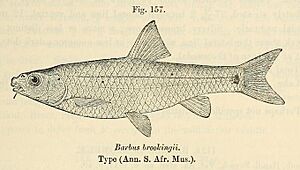Border barb facts for kids
Quick facts for kids Border barb |
|
|---|---|
 |
|
| Conservation status | |
| Scientific classification | |
| Synonyms | |
|
The border barb (Amatolacypris trevelyani) is a special type of ray-finned fish. This means it has fins supported by bony rays. It belongs to the family Cyprinidae, which includes many well-known fish like carps and minnows. The border barb is the only species in its group, called Amatolacypris. It's also unique because it's a "tetraploid" fish, meaning it has four sets of chromosomes instead of the usual two.
About the Border Barb
The border barb is a fascinating fish found only in South Africa. It's known for living in clean, clear streams. These streams often flow through forests, providing a perfect home for this unique species.
Where It Lives
This fish is endemic to South Africa, meaning it's found nowhere else in the world. It has only been discovered in the Keiskamma and Buffalo Rivers in the Eastern Cape Province. You can also find it in their smaller connecting streams, called tributaries, like the Mgqawabe and Yellowwoods Rivers.
The border barb prefers certain types of places in these rivers. It likes to live in quiet pools and fast-flowing areas called riffles. These spots usually have rocky ground. The streams it calls home are typically very clean and flow through forested areas.
What It Eats
The border barb is not a picky eater, but it does have its favorites! It mainly eats tiny insect nymphs, which are young insects living in the water. It also enjoys other small aquatic invertebrates, which are creatures without backbones. Sometimes, it will snack on plant seeds and even algae.
The time when border barbs lay their eggs, called spawning, happens in spring to early summer. This is usually around October and November in South Africa.
Why It's Endangered
The border barb is classified as Endangered by the IUCN (International Union for Conservation of Nature). This means it's at a high risk of disappearing forever. The main reason for this is its very limited range, meaning it only lives in a few specific rivers.
Even though its numbers don't seem to be dropping quickly, there are several threats to the border barb:
- Introduced Fish: Other fish species have been brought into its home rivers. These include the African catfish (Clarias gariepinus), largemouth bass (Micropterus salmoides), smallmouth bass (Micropterus dolomieu), and trouts (Oncorhynchus and Salmo). These introduced fish often compete with the border barb for food or even eat the border barb itself.
- Water Quality: In recent times, the quality of the water in these rivers has gotten worse. Pollution can harm the fish and the tiny creatures it eats.
- Deforestation: When trees are cut down along the riverbanks, it's called deforestation. This can cause soil to wash into the river, making the water muddy and harming the border barb's habitat. If deforestation continues, the border barb might not be able to live in these areas anymore.
Protecting the border barb means protecting its unique river homes from these threats.


